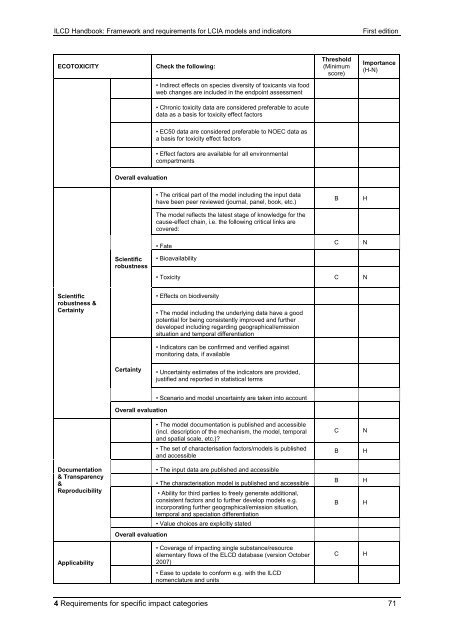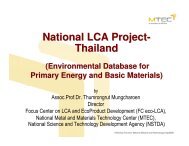ILCD Handbook: Framework and requirements for LCIA models and ...
ILCD Handbook: Framework and requirements for LCIA models and ...
ILCD Handbook: Framework and requirements for LCIA models and ...
You also want an ePaper? Increase the reach of your titles
YUMPU automatically turns print PDFs into web optimized ePapers that Google loves.
<strong>ILCD</strong> <strong>H<strong>and</strong>book</strong>: <strong>Framework</strong> <strong>and</strong> <strong>requirements</strong> <strong>for</strong> <strong>LCIA</strong> <strong>models</strong> <strong>and</strong> indicators First edition<br />
ECOTOXICITY Check the following:<br />
Scientific<br />
robustness &<br />
Certainty<br />
Documentation<br />
& Transparency<br />
&<br />
Reproducibility<br />
Applicability<br />
Overall evaluation<br />
Scientific<br />
robustness<br />
Certainty<br />
• Indirect effects on species diversity of toxicants via food<br />
web changes are included in the endpoint assessment<br />
• Chronic toxicity data are considered preferable to acute<br />
data as a basis <strong>for</strong> toxicity effect factors<br />
• EC50 data are considered preferable to NOEC data as<br />
a basis <strong>for</strong> toxicity effect factors<br />
• Effect factors are available <strong>for</strong> all environmental<br />
compartments<br />
• The critical part of the model including the input data<br />
have been peer reviewed (journal, panel, book, etc.)<br />
The model reflects the latest stage of knowledge <strong>for</strong> the<br />
cause-effect chain, i.e. the following critical links are<br />
covered:<br />
• Fate<br />
Overall evaluation<br />
Overall evaluation<br />
• Bioavailability<br />
Threshold<br />
(Minimum<br />
score)<br />
B H<br />
C N<br />
• Toxicity C N<br />
• Effects on biodiversity<br />
• The model including the underlying data have a good<br />
potential <strong>for</strong> being consistently improved <strong>and</strong> further<br />
developed including regarding geographical/emission<br />
situation <strong>and</strong> temporal differentiation<br />
• Indicators can be confirmed <strong>and</strong> verified against<br />
monitoring data, if available<br />
• Uncertainty estimates of the indicators are provided,<br />
justified <strong>and</strong> reported in statistical terms<br />
• Scenario <strong>and</strong> model uncertainty are taken into account<br />
• The model documentation is published <strong>and</strong> accessible<br />
(incl. description of the mechanism, the model, temporal<br />
<strong>and</strong> spatial scale, etc.)?<br />
• The set of characterisation factors/<strong>models</strong> is published<br />
<strong>and</strong> accessible<br />
• The input data are published <strong>and</strong> accessible<br />
• The characterisation model is published <strong>and</strong> accessible<br />
• Ability <strong>for</strong> third parties to freely generate additional,<br />
consistent factors <strong>and</strong> to further develop <strong>models</strong> e.g.<br />
incorporating further geographical/emission situation,<br />
temporal <strong>and</strong> speciation differentiation<br />
• Value choices are explicitly stated<br />
• Coverage of impacting single substance/resource<br />
elementary flows of the ELCD database (version October<br />
2007)<br />
• Ease to update to con<strong>for</strong>m e.g. with the <strong>ILCD</strong><br />
nomenclature <strong>and</strong> units<br />
C N<br />
B H<br />
B H<br />
B H<br />
C H<br />
Importance<br />
(H-N)<br />
4 Requirements <strong>for</strong> specific impact categories 71



